The pin-fire game gun was a test bed of sorts, which saw the development of many practical advances in gunmaking, mechanical design and decorative elements, including many that have carried through to the present day. We tend to think of the state of mid-Victorian Britain shooting sports in terms of the great battle for supremacy between the perfected muzzle-loader and the nascent breech-loader, but this isn’t the whole story. The British pin-fire game gun, first appearing around 1854, coincided with the beginning of gun-cotton and other smokeless (nitrocellulose) powders. As early as 1856, and during the short time the pin-fire game gun was popular, ending approximately around 1870, some sportsmen were experimenting with the new powders. Surprisingly, very little has appeared in print on this subject.
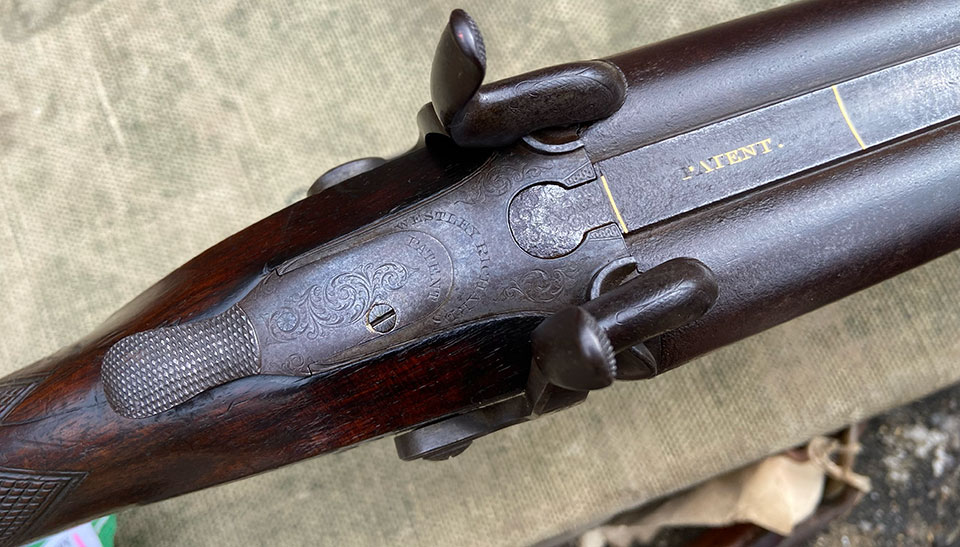
Gunpowder, also known as black powder, is the oldest known explosive, having been in use since about 1350. It is composed of potassium nitrate, carbon, and sulphur, in proportions that have remained relatively constant over the centuries. Anything using gunpowder as a propellant had to be up to the task, and in 1637, the gunmakers of London obtained a royal charter to protect the gunmaking profession and the safety of those who bought guns. The Charter marked the beginning of the London Proof House, later expanded in 1813 to add the Birmingham Proof House. All gun barrels needed to be tested to ensure their safety from defects and soundness under the pressure developed by the burning powder. With the adoption of the Gun Barrel Proof Act of 1855, both Proof Houses were brought under common Proof Scale Rules and Regulations. New rules have been adopted ever since to keep pace with advances in gunmaking practices, metallurgy, and powder development.
This new material provided less heat and smoke and up to six times the explosive force...
The history of smokeless powders began in 1832 when the French chemist Henri Braconnot mixed nitric acid and wood fibres to produce a very explosive material. In 1838, French chemist Theophile-Jules Pelouze produced explosive materials by treating paper and cardboard with nitric acid. However, both these resulting compounds were unstable and unpredictable. The Swiss chemist Christian Schönbein discovered in 1845 a more practical solution, anecdotally by accident. Schönbein immersed cotton fibres in a mixture of nitric and sulfuric acids and then washed out all traces of the acid. The washed, nitrated cellulose was dried, resulting in the compound known as nitrocellulose or gun-cotton. This new material provided less heat and smoke and up to six times the explosive force of the same volume of black powder. An Austrian officer, Nikolaus Wilhelm Freiherr Lenk von Wolfsberg, came up with a method to produce gun-cotton efficiently and in large quantities, which led to the adoption of gun-cotton by the Austrian military. However, gun-cotton was still unstable, which caused many accidents in its manufacture and use.
The first commercially produced smokeless powder was invented by a Prussian artillery officer, Captain Johann Edward Schultze, in 1860; his formula consisted of wood fibre cut into grains, purified, nitrated and finally impregnated with potassium nitrate or barium nitrate (as it included a component of black powder, this was more appropriately a ‘semi-smokeless’ powder). The British company, Thomas Prentice & Co. of Stowmarket, started manufacturing gun-cotton in 1863, followed by Sir Frederick Abel, who produced nitrocellulose at the Royal Gunpowder Mills at Waltham Abbey. Both were based on Von Lenk’s process but with improved purification. However, the Austrian, British, French, and Prussian governments stopped using and developing nitrocellulose propellants due to frequent accidents. Manufacturing of Schultze’s powder began in 1864, and it gained a good reputation in Britain among sportsmen, aided by an energetic promotion of the new powder by the Scottish gunmaker James D. Dougall in 1865.
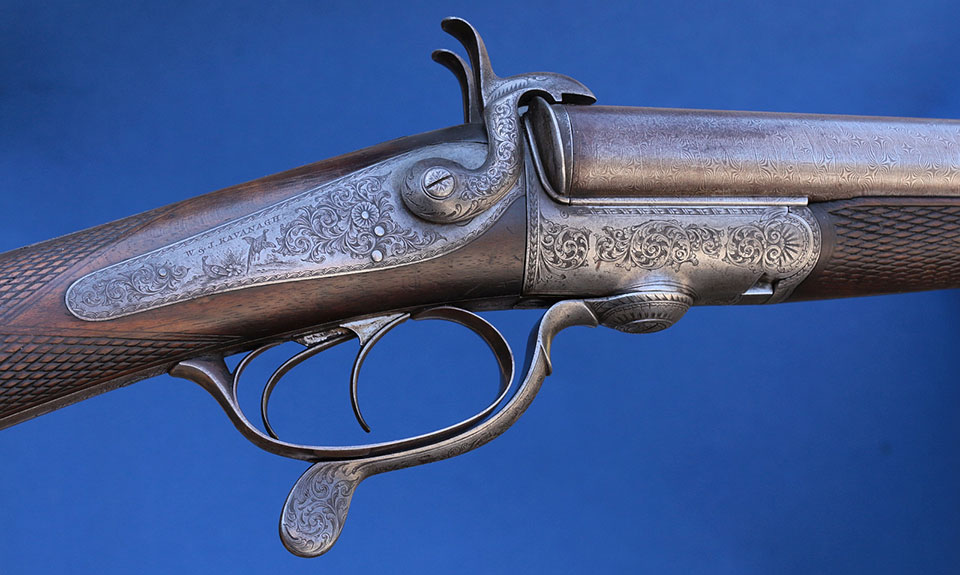
Schultze’s factory burned down in 1868, and in the same year, Schultze’s Granulated Wood Gunpowder Company Ltd was established at 9 Northumberland Street, Charing Cross, London, with a factory at Fritham, New Forest, by a consortium licencing Schultze’s process and name. Abel continued experimenting with his pulped and purified gun-cotton, which he could compress into various shapes. In 1867 and 1868, he got some promising results when used with field artillery. However, the British military was still very wary of gun-cotton and was more concerned about safety issues than the advantages of smokeless powder. The Thomas Prentice & Co. factory blew up in 1871, prompting another reason why the British military discontinued further research in gun-cotton for artillery and small arms for about twenty years. Instead, compressed gun-cotton was used exclusively in naval mines and torpedoes, and the entire gun-cotton production at the Waltham Abbey factories went towards these uses for the next couple of decades.
The creation of nitrocellulose led to the discovery that certain solvents could soften the material, resulting in a mouldable mass. Advances fell primarily into making the manufacturing process safe and repeatable, developing ways to shape nitrocellulose into granules, and adding chemical treatment to control the energy release rate. Two types of solvents were used: an alcohol/ether mixture produced “single-base” propellants, where the solvents contributed very little energy, and those where nitro-glycerine was the chemical solvent, producing “double-base” propellants, where the solvent contributed significant energy to the reaction (nitro-glycerine was discovered in 1847 by the Italian chemist Ascagne Sobrero, but it was not applied as an explosive until 1864).
an alcohol/ether mixture produced “single-base” propellants, where the solvents contributed very little energy
While the history of gun-cotton and smokeless powders is fascinating, I am most interested in their use in pin-fire game guns, hitherto known only as black-powder guns. To anyone keeping track of the above dates, it is remarkable that the first mention of using gun-cotton cartridges in pin-fire game guns appeared in the Dec. 27, 1856, issue of the London-based sporting weekly newspaper The Field:
“Sir,— In answer to CURIOUS, I will venture to say that there are a thousand and one reasons, et amplius, which are obvious, why a well-constructed breech-loading shot-gun is preferable to one that loads at the muzzle; but, to carry out this desideratum, you must use gun-cotton cartridges. This I have successfully proved by using Cooper’s breech-loading shot-gun. I am quite ready to show the advantage of gun-cotton cartridges over any gunpowder that I am acquainted with, to any gentleman who will favour me with a visit at the Rosherville Hotel, by firing a few of them from the small revolver-pistol that I used about a year ago at Enfield, in presence of the select committee of artillery officers there – but of which proof I have not as yet received any official report, although I went there by an official invitation. J. NORTON, Rosherville, Dec. 24.”
The correspondent was Captain John Norton. He was born in Ireland circa 1788 in an English family and had served in the 34th Regiment of Foot during the Peninsular War. The chance explosion of an ammunition wagon at the Battle of Busaco in 1810 led him to the study of military projectiles, and in 1923, he invented what came to be known as the ‘Minie’ bullet, which he presented to the Select Committee on Firearms at Woolwich in 1826. His invention was rejected in favour of the spherical Brunswick ball as the preferred rifle projectile. In 1849, Captain Claude-Étienne Minié of the French Army produced a somewhat similar bullet, which was adopted by the British War Office in 1852. There was a subsequent campaign in Britain to get Norton credited for his invention and rewarded for his efforts.
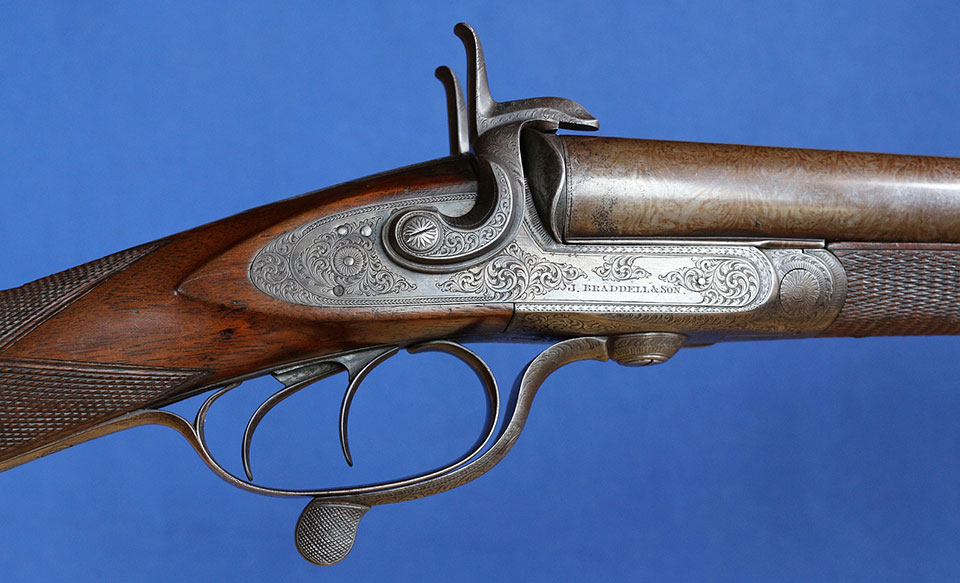
Between 1854 and 1861, Norton’s address was in Dublin. However, in his writings to The Field, his address was always the Rosherville Hotel, Rosherville, near London along the Thames. He was an eccentric character and a prolific correspondent, and in 1860, a collection of his letters to newspapers and journals was published as A List of Captain Norton’s Projectiles and his Other Military and Naval Inventions; with Original Correspondence.
Norton wrote again to The Field, and in the Sept. 5, 1857, issue, he recommended his gun-cotton cartridge for the American-made Sharps carbine. His correspondence in The Field was noticed by others, and in the Sept. 12 issue, the frequent correspondent “A Soldier,” a proponent of the pin-fire system, asked of Norton’s cartridges: “If they would not suit the now common breech-loading shot gun, and if so, where can I procure them?” Norton replied, appearing in the Sept. 26 issue:
“Sir,— It was only on Saturday last that I read the letter from “A Soldier,” in The Field, and, in answer, I have the pleasure to inform him that my cartridge is adapted to every description of breech-loading arms; and, that one or two respectable gunmakers in London will supply the cartridges on receiving an order describing the nature of the breech-loader for which they are required. J. NORTON, Rosherville, Sept. 23.”
The correspondent “A Soldier,” replying on another matter in the Nov. 28 issue, added the postscript: “Capt. Norton said his cartridges for breech-loaders, filled with gun-cotton, might be got at several gunmakers’ in town. I wish he would name them.” Unfortunately, Norton never did, leaving the subject entirely open to speculation as to the source of the gun-cotton, its formulation and strength, who amongst London gunmakers were supplying gun-cotton in prepared cartridges, and who were using them.
The subject of loading and re-loading pin-fire cartridges was a common one in the pages of The Field, usually focussing on cost, loading formulas, and the procurement of cases. While there was no specific mention of gun-cotton, one correspondent writing to the newspaper in the Nov. 3, 1860, issue provided the editor with a spent case supporting his argument on the reloadability of casings. The empty case was manufactured at the Fabrique Gevelot in Paris and sold by the London gunmaker Benjamin Cogswell.
Walsh was already aware of the effect of the more powerful propellant based on potassium chloride and sulphur
The lack of black powder residue in the intact, twice-fired case prompted the editor, John Henry Walsh, to comment: “We should very much like to possess a large stock of powder which would leave as little residuum as there is in the case sent us.” While this may have involved gun-cotton, Walsh was already aware of the effect of the more powerful propellant based on potassium chloride and sulphur, writing in the 15 Dec. issue: “The objection to all these quickly-exploding powders is, that they burst the gun. Gun-cotton is, on this score, too dangerous to be used except in very small charges.” In the following issue of Dec. 22, Walsh addressed the matter in more detail in a column titled New Gunpowders, noting:
“From time to time the public have been tantalised by announcements of various new explosive compounds, which were said to be superior to the black and dirty-looking powder with which we are all familiar. But, when put to the proof of practical experiment, each has been found wanting in the exact amount of propelling force suited to the kind of work which is to be accomplished. Fulminating silver and mercury, chlorate of potass mixed with sulphur, gun-cotton, and a host of chemical preparations similar in their nature to the above, all produce an enormous amount of gas on explosion, and give it off more quickly than ordinary gunpowder; but, in proportion to the perfection of the decomposition is each of these objectionable, because the strain upon the metal confining them is relatively far greater than that produced by gunpowder.”
It was not before Feb. 14, 1863, that the subject came up again, with Walsh noting: “…several asserted improvements in the explosive compounds used with guns have lately been published. In this country gun-cotton has never found favour with our gunmakers and experimentalists, but in Austria it has held its own ever since its invention by Schonbein, and Baron Lenk has now given to the world an improvement in its manufacture…”
The view on gun-cotton changed with the improved product. In the Jun. 4, 1864, issue of The Field, Walsh wrote a column on the re-introduction of gun-cotton, noting: “Within the last few months, the proposed re-introduction of gun-cotton, as a substitute for gunpowder, has been attracting great attention amongst scientific and practical men, both in this country and on the Continent; and recently a large factory has been established in England for its manufacture.” This was a reference to the Thomas Prentice & Co. factory. Walsh finished by saying: “We shall watch the progress of the re-introduction of gun-cotton with interest, and shall not fail to lay the practical results before our readers as soon as they are ascertained.”
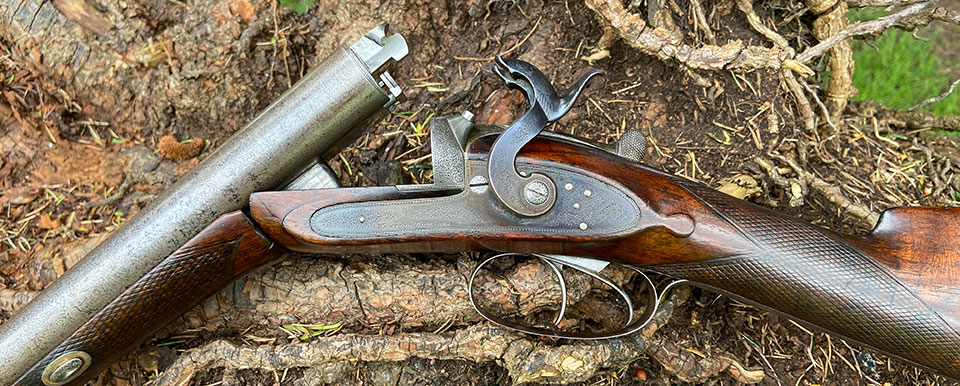
This statement started a lengthy discussion on using Prentice’s gun-cotton, coinciding with the peak years of manufacturing pin-fire game guns. Prentice & Co. began advertising their gun-cotton cartridges in The Field in September 1865. They promised uniform power, greater penetration, little recoil, lack of fouling, and the cartridges would not “injure the gun.” Positive comments from sportsmen began appearing in the newspaper in October, mostly repeating the claims of the manufacturer. In the 21 October issue, Walsh reported on his own tests with the new gun-cotton pin-fire cartridges in comparison with regular cartridges, finding a ten percent improvement in penetration, diminished recoil, and reduced fouling and smoke. Walsh did find that the pin-fire cases split when used with gun-cotton, while the cases fired with gunpowder could be re-used. Despite their single use, Walsh recommended the use of Prentice & Co. gun-cotton cartridges. At least one correspondent repeated Walsh’s test, achieving the same results.
It was not before the Jan. 6, 1866, issue of The Field that a correspondent, recognizing the increasingly widespread use of Prentice & Co. gun-cotton cartridges, pointed out the inherent danger of using these in guns proofed for the use of gunpowder only, having just lost a top-quality gun that had burst at the chamber, and having heard of similar results from others. The correspondent also pointed out that gun-cotton had just been prohibited in Austria, and that a prominent Belgian gunmaker had concluded that gun-cotton was too powerful for the metals in use. This, in turn, led to a veritable flood of responses in defence of gun-cotton cartridges used in pin-fire game guns, with some pointing out that even muzzle-loaders occasionally burst at the breech, using ordinary powder. From these letters, it can be deduced that the use of gun-cotton cartridges in pin-fire guns had become common for many sportsmen. Surprisingly, the subject of guns not being proofed for the new powders never came up again.
The Field announced in its Jan. 27, 1866, issue that a new public field trial would be conducted to test the varieties of breech-loading actions, pin- and central-fire cartridges, and gun-cotton versus gunpowder (including the new Schultze powder).
In the Feb. 10, 1866 issue, the manufacturers, Prentice & Co., responded to the many letters published in support of their product, adding that they had fired several thousands of their cartridges from the same gun without ill effect, thousands of cartridges had been ordered by H.R.H. the Prince of Wales, and that their formulation of gun-cotton for sporting purposes was different in composition to that used for military ends.
The Field gun trial was held in May, but Prentice & Co. could not provide sufficient gun-cotton cartridges for the trial, and neither could a fresh supply of Capt. Schultze’s powder be obtained. As a result, the trial did not test the new powders.
In the Jul. 28, 1866, issue, The Field published a comparison of gunpowder, Schultze’s semi-smokeless powder, and gun-cotton (in this case, Dixon’s gun-cloth as supplied by Bussey & Co. of London). The experiment showed a slight advantage of gunpowder in penetration, equality in patterning, and benefits of the new powders regarding cleanliness, recoil and smoke. Both central-fire and pin-fire cartridges were put to the test, as both were in common use at this time, though the agent for Captain Schultze’s powder claimed this test was the first occasion their powder had been used in a central-fire cartridge.
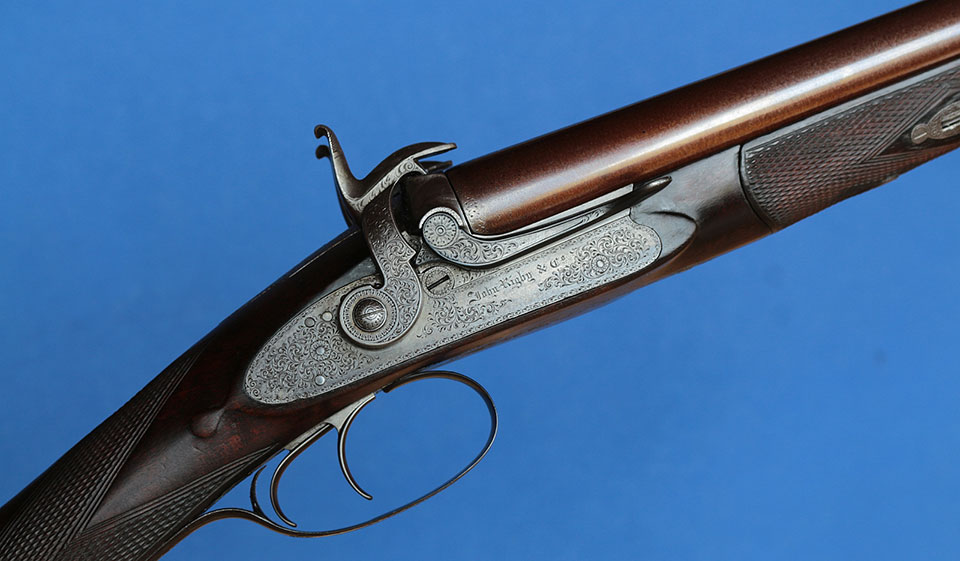
Subsequent correspondence in The Field suggested that gun-cotton would be widely used in the upcoming shooting season. In the Aug. 11 1866 issue, one correspondent assured readers that: “Gun-cotton in all probability will be largely used this season; and judging from last year’s experience, as well as from trials which you have made and from the information that anyone can get from the manufacturers as to the perfect control which is obtained over the combustion, I have no doubt whatsoever that it may be used with entire safety.” In the shooting press at this time, no distinction was being made between pin-fire and central-fire guns, both being considered equal. However, The Field began to doubt the safety of gun-cotton cartridges. In reaction to several accounts of accidents using gun-cotton cartridges, Walsh wrote in the 20 October issue:
“As to the application of gun-cotton for sporting purposes, we regret to say that no substantial progress appears to have been made in the construction of a good cartridge. Nothing can more clearly illustrate the truth of our remark than the fact that a manufacturing firm, supposed to be well advised on the subject , have, in rapid succession, altered the construction of their cartridge several times during the present season; and we fear that there is too much truth in Mr Révy’s observation that “we are at the mercy of manufacturers whose experience dates but from yesterday, and who are virtually experimenting at the expense and risk of the public.” Should our Government continue to neglect the subject so clearly brought before us by Mr. Révy’s, we see no hope of any progress being made except by the formation of a committee of scientific men, who should carefully test the various new cartridges and explosive compounds now offered to the public. At present we have no hesitation in coming to the conclusion that the path of safety lies in the direction of the use of the old-fashioned powder.”
we are at the mercy of manufacturers whose experience dates but from yesterday,
Julian John Révy was an engineer, originally from Vienna, Austria, who was well-versed in the science of gun-cotton. He had advised Prentice & Co. on the establishment of their operation, and had obtained a patent in 1865 from the US Patent Office for improvement in the manufacture of gun-cotton. As a result, his views and concerns over the use of gun-cotton in sporting arms were taken seriously. The Field and its editor, Walsh, held the view that while it would not state that gun-cotton cartridges were dangerous, not enough was known to declare them safe. This prompted much more correspondence, mostly in favour of the new cartridges.
The Nov. 10, 1866, issue saw the return of the correspondent “A Soldier,” whose letters were part of the original discussion in 1856. He described how Prentice’s gun-cotton cartridges were much improved over previous seasons, stating: “I venture to hazard a prediction with as much confidence as I did when I first, in 1856, took to breech-loaders—namely, that in a few years gunpowder will be as little thought of as muzzle-loading guns are now.” He then added: “Mr. Horsley, the gunmaker at York, told me the other day, respecting the gun-cotton cartridges, that some of his customers, shooting thousands of cartridges in the season, told him they would just as soon taking up a muzzle-loader again as give up gun-cotton and return to gunpowder.”
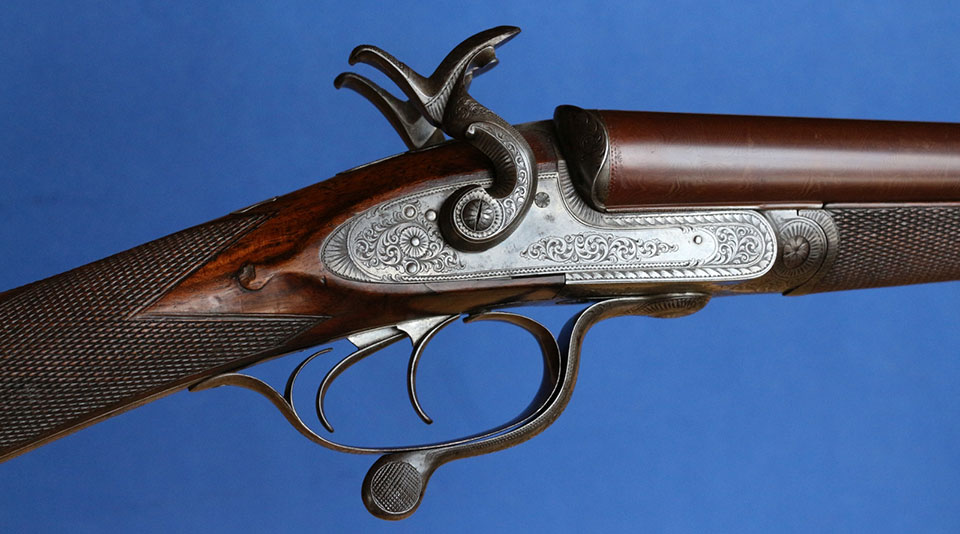
The debate ran on at length, often with a touch of acrimony. By this time, Schultze’s powder was on the market (supplied by the well-known gunmaker James D. Dougall), competing with Prentice & Co. cartridges and other gun-cotton cartridge makers. The back-and-forth in the letters columns of The Field continued well beyond 1870, the point at which demand for the pin-fire game gun was in decline, and my research on the subject ends. Undoubtedly, the supply of gun-cotton cartridges was much reduced after the explosion of the Prentice & Co. factory in 1871. Despite the popularity of the cartridges, it took until 1896 for the Proof House regulations to finally catch up with the use of gun-cotton and smokeless (nitrocellulose) powders in sporting guns. While pin-fire game guns were never proofed for these powders, many saw a steady diet of them, a fact that I had not fully appreciated before delving into The Field’s first two decades in print.
Much new information can be learned from reading contemporary accounts!
Words and photos by Stephen Nash
Published by Vintage Guns Ltd on




